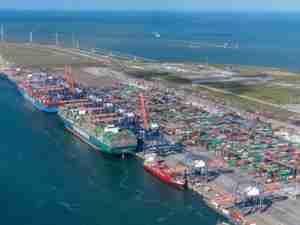“The Masonville Cove restoration project is one of Maryland’s great environmental success stories,” said Governor Martin O’Malley. “In our clean up of the waterfront, we have removed thousands of tons of trash and debris dating back more than a century. When complete, Masonville will be a recreation center for the surrounding communities and a place for young and old alike to learn about the local environment.”
The centerpiece of the Masonville restoration project is the environmental education center which opened in 2009. It is a “near-zero, net-energy” building, which uses the latest environmental advances. The building includes: a ground-source air conditioning system that uses about half the energy of a conventional building; solar energy power; rain barrels that collect roof rain runoff to water greenery and flowers; a reflective roof that decreases the amount of heat transferred into the building; and an energy recovery ventilator where exhaust air is used to heat or cool fresh air using a heat exchanger, making ventilation more efficient.
The Living Classrooms Foundation and the National Aquarium in Baltimore develop and run the education programs for the center. Since opening its doors last year, more than 2,000 Maryland children and adults have visited the center and learned about the local environment, wildlife and importance of recycling.
The environmental education center is just part of a larger restoration project of more than 54 acres of shoreline along the Patapsco River’s Middle Branch near the Brooklyn and Curtis Bay communities. Other key elements include a new environmental park and wildlife area; a series of hiker-biker trails that will provide local residents access to the Patapsco River; a boat ramp limited to non-power boats like kayaks and canoes; and improvements to stream and fish habitat. Long term plans include developing a new marine terminal for the Port of Baltimore using dredged material to build a containment site on the remaining 141 acres.
The MPA has worked since the beginning of this project with citizens of the neighboring communities of Brooklyn and Curtis Bay. Since the beginning, representatives told the MPA that one of their reasons for supporting this initiative was to show their children the importance of caring for the environment.
In 2007, the MPA began the project with a massive clean up. More than 61,000 tons of trash and debris have been removed. Some of the debris dates back more than a century to the Great Baltimore Fire of 1904. To date, the clean-up has included the removal of:
- 306,074 gallons of petroleum-tainted water;
- 17,398 tons of timber;
- 6,588 tons of concrete rubble;
- 5,265 feet of electrical wire; and
- 4,047 pounds of PCB-containing electrical equipment.
Besides trash, there are also 27 abandoned vessels being remediated or removed from the water at the site. The site is the former home of Kurt Iron and Metal and the Maryland Shipbuilding and Drydock Company.
The Masonville Cove project brings together many goals of Maryland’s Smart, Green and Growing initiative, a multi-agency, Statewide program to help Maryland achieve a more sustainable future by linking community revitalization, transportation improvements, economic development, smart growth and environmental restoration efforts.










